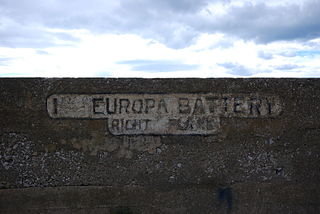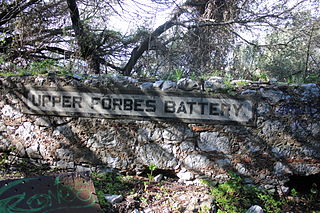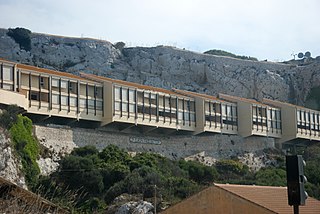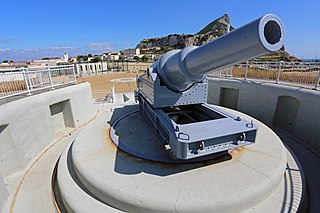
Farringdon's Battery is an artillery battery in the British Overseas Territory of Gibraltar. Named after Sir Anthony Farrington, 1st Baronet, it is located above the north face of the Rock of Gibraltar within the Upper Rock Nature Reserve.

Buena Vista Battery was an artillery battery near the Buena Vista Barracks at the southern end of the British Overseas Territory of Gibraltar. It is located on a slight ridge in front of the nearby Buena Vista Barracks, which was once the base of the Royal Gibraltar Regiment.

Devil's Tongue Battery was an artillery battery in the British Overseas Territory of Gibraltar. The battery could overlook the harbour but the remains are now surrounded by reclaimed land.

The Europa Batteries are a group of artillery batteries in the British Overseas Territory of Gibraltar. Facing the North African coast, they are the most southerly batteries in Gibraltar and were built to cover ships approaching from the Mediterranean Sea. They run along the fortified clifftops of Europa Point from Camp Bay on the west side of the Rock of Gibraltar to the Europa Advance Batteries on the east side.

Forbes' Batteries are a pair of artillery batteries in the British Overseas Territory of Gibraltar. The batteries are casemated.

Gardiner's Battery is an artillery battery in the British Overseas Territory of Gibraltar. It is named after the governor Sir Robert Gardiner.
Jones' Battery is one of the best preserved of the "retired" artillery battery in the British Overseas Territory of Gibraltar. It was named after Sir John Thomas Jones who once controlled the fortifications here.

Queen Charlotte's Battery is a 1727 artillery battery in the British Overseas Territory of Gibraltar.

Saluting Battery was an artillery battery in the British Overseas Territory of Gibraltar.

Europa Pass Batteries are a group of artillery batteries in the British Overseas Territory of Gibraltar. They are located north west of Europa Point in the south of Gibraltar, just off Europa Road.

Harding's Battery is a restored artillery battery in the British Overseas Territory of Gibraltar. It is located at Europa Point and includes the Europa Sunken Magazine that is now used as a visitor centre.

Alexandra Battery is a coastal artillery battery in the British Overseas Territory of Gibraltar. It was constructed at the neck of the South Mole to enfilade the coastal fortifications of Gibraltar. The battery stood on the site of several previous fortifications; it was built over the New Mole Battery, which was itself constructed on the site of an old Spanish fort in front of the Tuerto Tower.
Civil Hospital Battery was an artillery battery in the British Overseas Territory of Gibraltar.
Cumberland Flank Battery was an artillery battery in the British Overseas Territory of Gibraltar.
Engineer Battery was an artillery battery in the British Overseas Territory of Gibraltar.
Half Way Battery was an artillery battery in the British Overseas Territory of Gibraltar. The battery was on the coast on the eastern side of the isthmus just north of Europa Point Lighthouse. In 1859 there were two guns.
Lady Augusta's Battery was an artillery battery in the British Overseas Territory of Gibraltar.
Prince of Wales Battery is an artillery battery in the British Overseas Territory of Gibraltar.
Woodford's Battery was an artillery battery in the British Overseas Territory of Gibraltar. It is located at Europa Flats between the Defensible Barracks and the Officer's Barracks and Eliott's Battery.

The Gibraltar peninsula, located at the far southern end of Iberia, has great strategic importance as a result of its position by the Strait of Gibraltar where the Mediterranean Sea meets the Atlantic Ocean. It has repeatedly been contested between European and North African powers and has endured fourteen sieges since it was first settled in the 11th century. The peninsula's occupants – Moors, Spanish, and British – have built successive layers of fortifications and defences including walls, bastions, casemates, gun batteries, magazines, tunnels and galleries. At their peak in 1865, the fortifications housed around 681 guns mounted in 110 batteries and positions, guarding all land and sea approaches to Gibraltar. The fortifications continued to be in military use until as late as the 1970s and by the time tunnelling ceased in the late 1960s, over 34 miles (55 km) of galleries had been dug in an area of only 2.6 square miles (6.7 km2).












